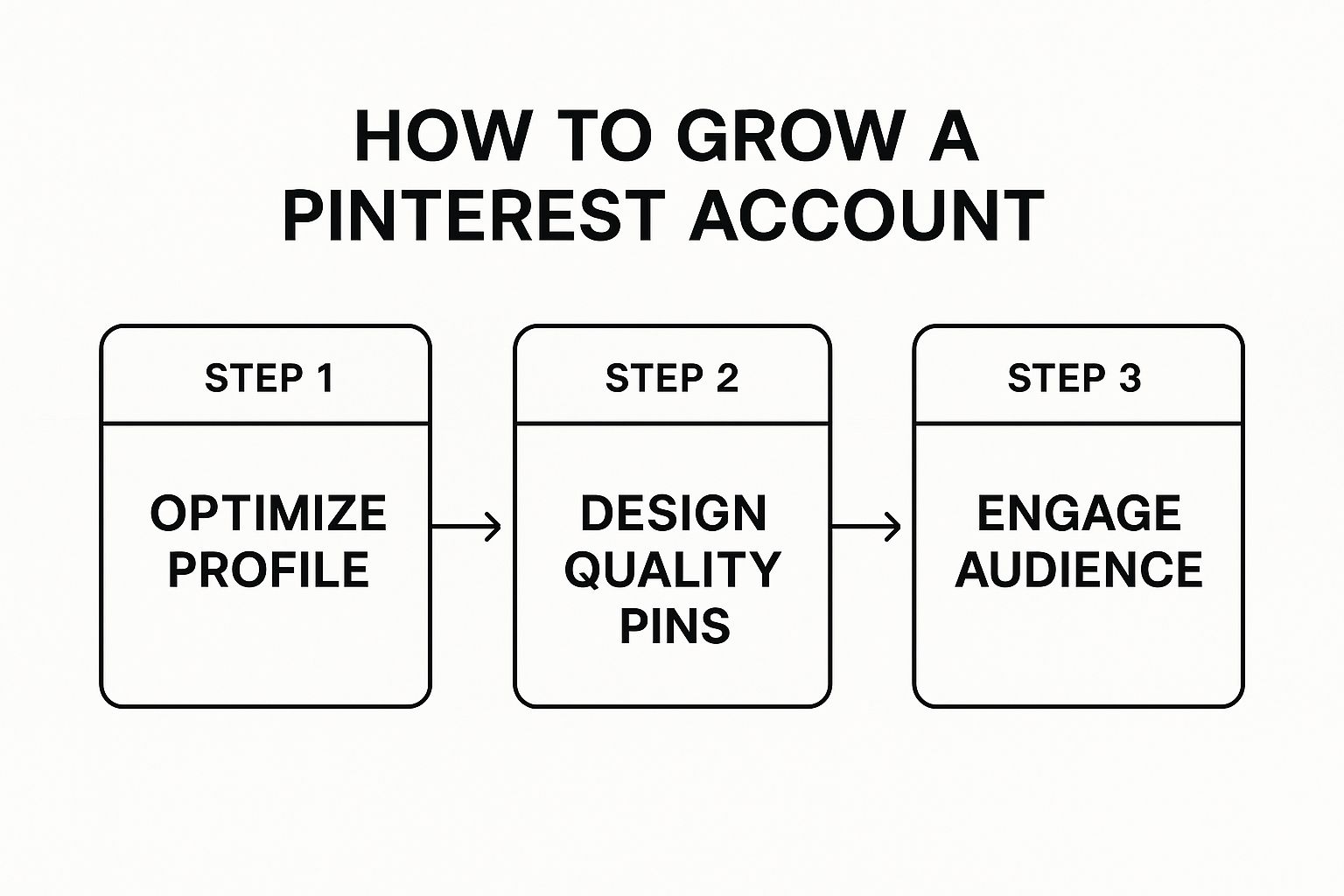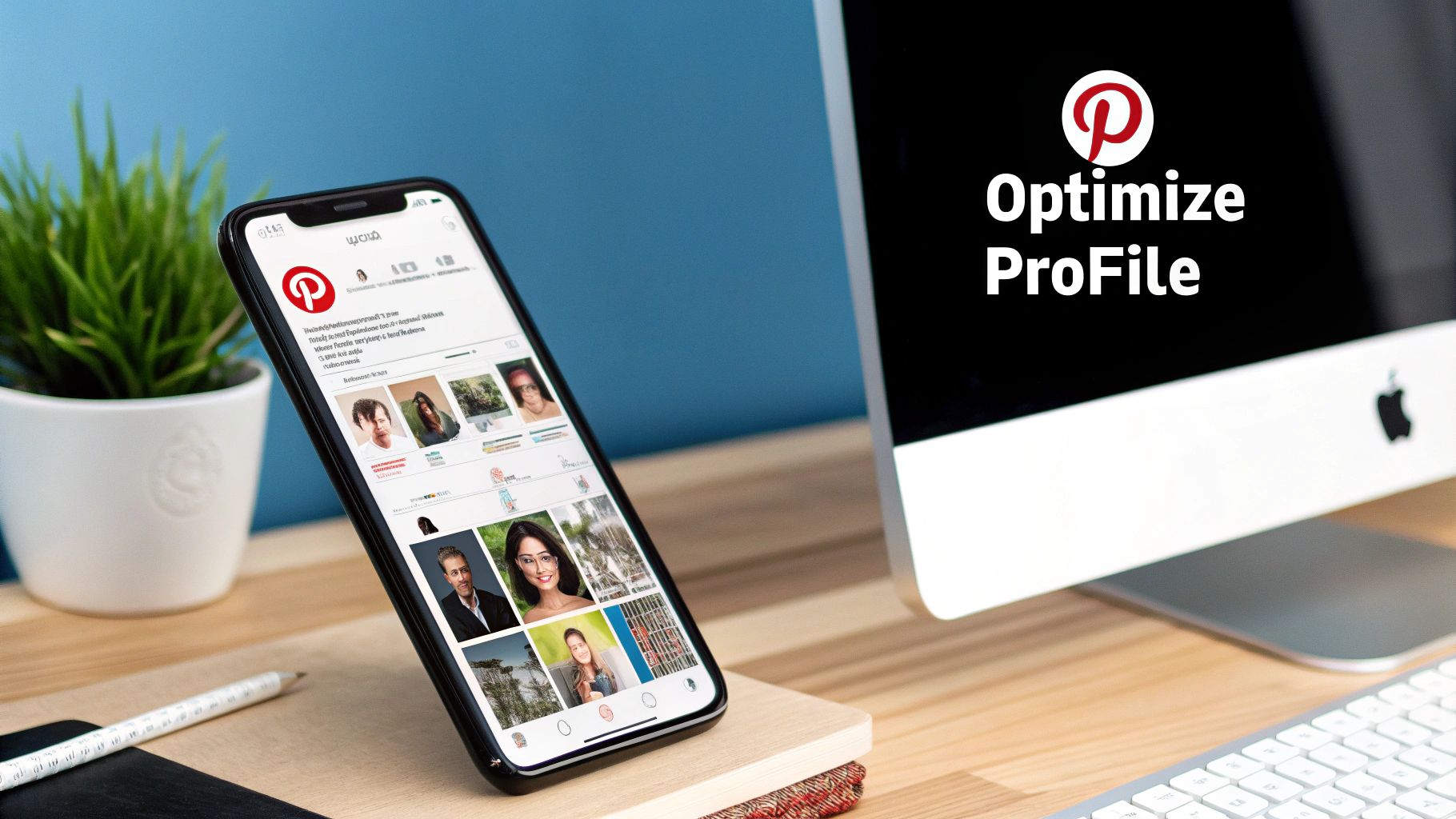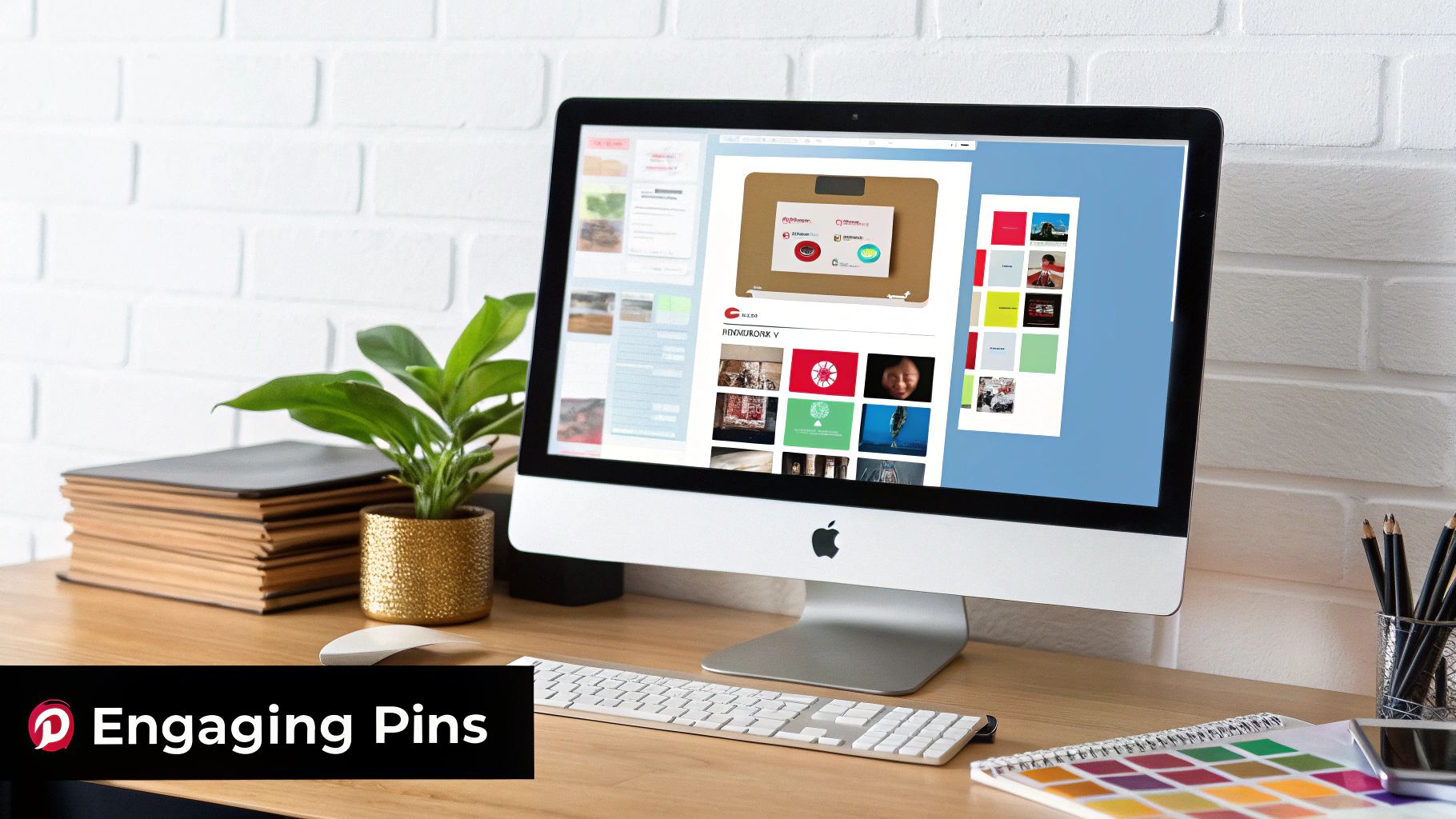How to Grow Pinterest Account Fast | Proven Tips & Tricks
Before you can even dream of a Pin going viral, you have to lay the groundwork. Growing a Pinterest account is all about building a solid, optimized foundation from the very start. Think of it as telling the Pinterest algorithm exactly what your brand is about, which gives every single Pin you create later a massive head start.
Build a Foundation for Pinterest Growth
Your Pinterest profile is your brand's digital storefront. You wouldn't expect customers to flock to a messy, unfinished shop, and the same logic applies here. A poorly optimized profile simply won't attract followers or drive traffic.
This initial setup isn't just about ticking boxes. It’s a strategic process. Every element, from your username to your board descriptions, works together to signal your niche to both Pinterest and potential followers. Get this right, and you're making your account discoverable, trustworthy, and irresistible to your ideal audience. An unoptimized profile is just a missed opportunity—like hiding a fantastic product in a plain brown box.
From Personal to Professional: A Business Account Is Non-Negotiable
If you're serious about growth, the first thing you need to do is switch to a Pinterest Business account. It's free, and frankly, it's not optional if you want real results. Without it, you're essentially flying blind.
A business account immediately unlocks a whole suite of professional tools. The most critical ones are:
Making the switch is easy and instantly adds a layer of professionalism to your presence. You're telling Pinterest you’re a serious creator, and the algorithm tends to favor that.
This graphic breaks down the entire process for growing a Pinterest account, and it all begins with the profile optimization we're talking about right now. As you can see, a strong profile is the launchpad for everything that follows, from creating killer content to building a real community.

Crafting a Magnetic and Searchable Profile
Okay, with your business account active, let's fine-tune the details. Your username needs to be clean, easy to remember, and—if possible—the same as your handles on other social platforms for brand consistency.
Next is your bio. You get 160 characters to make an impression, so don't fill it with fluff.
Finally, claiming your website is a crucial step. It proves to Pinterest that you own your domain, which unlocks analytics for any Pin ever created from your site—even if someone else pinned it. This creates a powerful, direct link between your Pinterest efforts and your website traffic.
To make sure you haven't missed anything, I've put together this quick checklist. Run through it to ensure your profile is primed for discovery right from the get-go.
Pinterest Profile Optimization Checklist
Once these foundational pieces are in place, you've built a strong launchpad for all your future pinning strategies. You’re no longer just hoping for the best; you're strategically positioning your brand for success on the platform.
Create Pins That People Actually Save

A well-optimized profile gets you in the game, but it's your Pins that will make you a winner. I’ve seen it time and again: explosive Pinterest growth doesn't come from just pinning a lot—it comes from creating Pins that people can't resist saving.
Every single save tells the Pinterest algorithm that your content is valuable, which in turn gets it shown to more people. It’s a powerful feedback loop. This means you have to move beyond generic, slapped-together designs. Your goal is to create something that solves a problem or sparks enough curiosity that a user instinctively thinks, "I need to save this for later."
Anatomy of a High-Performing Pin
Before you even think about opening Canva, you need to understand the visual language of Pinterest. This platform is unapologetically vertical, and your Pins must embrace that to claim as much screen real estate as possible.
Let's start with the basics: dimensions. The golden aspect ratio is 2:3. For most people, that means creating designs at 1000 x 1500 pixels. Sticking to this vertical format is non-negotiable if you want your Pins to stand out in a crowded feed.
Next up is your imagery. Your photos and graphics need to be top-notch. I'm talking high-quality, high-contrast visuals that pop. Blurry, dark, or generic stock photos are the kiss of death—they get scrolled past in a heartbeat. The image you choose has to be crisp, vibrant, and directly related to your Pin's topic.
The text overlay is your hook. It has to be bold, easy to read, and communicate the main benefit almost instantly. Use a clean, simple font that’s legible on a tiny mobile screen and make sure it contrasts sharply with the background. For instance, a Pin for a "Vegan Lasagna Recipe" should have those exact words front and center, not buried in some hard-to-read script font.
Finally, remember to brand your Pins. A small logo or your website URL tucked into a corner is all you need. It builds brand recognition over time and helps protect your content from being stolen. Just make it subtle—it shouldn't be the main event. For a more detailed breakdown, you can learn more about how to optimize Pinterest Pins in our other guide.
Choosing the Right Pin Format for Your Goal
Pinterest has simplified its Pin formats over the years, but knowing the difference between them is still crucial for a smart strategy. Each type serves a unique purpose, and matching your content to the right format can make a world of difference in your results.
Static Pins
These are the classic, clickable image Pins that we all know. They link directly to an external URL, like your latest blog post or a product page. For anyone focused on driving traffic back to their own website, these are the absolute workhorse of your Pinterest strategy.
Video Pins
Short-form video is a huge deal on Pinterest. Video Pins autoplay in the feed, which makes them fantastic for grabbing attention and stopping the scroll. They are an incredible tool for showing a process or telling a quick story.
Idea Pins
Idea Pins (which have evolved from the old Story Pins) are multi-page Pins designed to provide a full experience right on the Pinterest platform. They are a sequence of images or video clips that tell a complete story, almost like a mini-blog post. While they don't link out from every slide, they are incredibly powerful for building an engaged audience and racking up impressions.
Master Pinterest SEO for Organic Reach
First things first, let's get one thing straight: Pinterest is not a social network. It's a massive visual search engine. Grasping this distinction is the single most important key to unlocking sustainable, long-term growth.
Creating beautiful Pins is definitely part of the equation, but it’s only half the battle. If you really want to grow your Pinterest account, you have to master Pinterest SEO. This is your ticket to getting discovered by people who are actively looking for the exact ideas, solutions, and products you provide—all without spending a dime on ads.
Finding the Keywords People Actually Use
Every solid SEO strategy starts with great keyword research. Your goal is to get inside the head of your ideal follower and figure out the exact phrases they’re typing into that search bar. Lucky for us, Pinterest gives you some fantastic (and free) tools to play detective.
The most obvious place to start is the Pinterest search bar itself. Go ahead and type in a broad term relevant to your niche—let's say "healthy dinner." Before you even hit enter, watch what happens. Pinterest instantly gives you a dropdown list of popular, related searches. These aren't just guesses; they're the real-time queries people are using most.
But don't stop there. After you search for your broad term, look at the colorful bubbles that pop up right underneath the search bar. This is Pinterest's guided search feature, and it is an absolute goldmine. For our "healthy dinner" example, you’ll likely see bubbles like "recipes," "quick and easy," "for family," and "on a budget."
These are the building blocks for powerful long-tail keywords that signal exactly what a user wants. You can start combining them to create super-specific phrases your audience is searching for:
These are the terms you want to build your content around. They're far less competitive than the broad terms and are used by people who are much closer to taking action.
Where to Place Your Keywords for Maximum Impact
Okay, so you've got a solid list of keywords. Now what? It's time to strategically sprinkle them across your entire Pinterest presence. Think of it like leaving a trail of breadcrumbs for the Pinterest algorithm, making it incredibly easy for it to understand your content and show it to the right people.
Consistency is everything. You need to weave these terms into every part of your account to continuously signal what you're all about.
Here’s your checklist for keyword placement:
By consistently applying this SEO framework, you'll transform your Pinterest profile from a simple mood board into a powerful, searchable resource. This is how you stop chasing fleeting trends and start building a reliable engine for organic traffic and steady growth.
Develop a Realistic Pinning Strategy

You've probably heard the advice to "be consistent" on Pinterest a million times. It's true, but it's also frustratingly vague. What does consistency actually look like in practice?
It’s not about overwhelming yourself. It's about building a simple, repeatable workflow that keeps your account active without leading to total burnout. A successful pinning strategy is one you can actually stick with for the long haul. Forget the old advice about pinning dozens of times a day; modern Pinterest growth is built on quality and strategic frequency, not just sheer volume.
Finding Your Pinning Sweet Spot
Let's clear the air: there is no magic number of Pins you have to publish every day. Some experts I know swear by 1-5 Pins per day, while others have found success with more. The real key is focusing on fresh, high-quality content instead of chasing an arbitrary quota.
Consistency will always beat intensity. Pinning three new, well-designed Pins every single day is far more effective than dropping 20 Pins one day and then ghosting the platform for a week. The algorithm rewards a steady stream of new content because it signals you're an active and reliable creator.
My advice? Start with a number that feels totally manageable—even one new Pin per day—and build from there. The goal is to find a rhythm that fits your schedule and your ability to create content. This is how you avoid that all-too-common cycle of intense effort followed by complete exhaustion.
What Pinterest Considers a Fresh Pin
Understanding the idea of a "fresh Pin" is probably the most critical part of your strategy today. This is Pinterest's term for a new image or video that has never been seen on the platform before. The algorithm heavily, heavily prioritizes new creative, so this is where you need to focus.
So, what counts as a fresh Pin?
What it is not is repinning the exact same Pin image to a different board. While sharing other people's content has its place, repinning your own old Pins offers almost no SEO value anymore compared to just publishing a fresh graphic.
Manual Pinning vs. Automation Tools
The great debate: should you pin manually or use a scheduler like Post Paddle or Tailwind? Honestly, both approaches have their merits, and the right choice really comes down to your personal workflow.
Let's break down the real pros and cons.
From what I’ve seen, many of the most successful creators use a hybrid approach. They might use a scheduler to handle their core content calendar—the "must-post" Pins—and then hop onto the platform manually to engage with trends, comment, and get a feel for what's happening.
This gives you the best of both worlds: the efficiency of automation and the authenticity of manual engagement. Ultimately, the best strategy is the one that removes friction and helps you show up consistently without losing your mind.
Use Analytics to Make Smarter Decisions
You can't improve what you don't measure. Pinning content without ever peeking at your data is like driving blindfolded—you might move forward, but you have no idea where you're going. That’s why getting comfortable with Pinterest Analytics is absolutely essential for real, strategic growth.
Think of it this way: your analytics dashboard is a direct line to your audience. It stops you from guessing what they want and lets you give them exactly what they're looking for. This isn't just a "nice to have"; it's how you turn random pinning into a predictable growth engine.
Key Metrics That Actually Matter
Opening your analytics for the first time can feel like a lot. Don't get bogged down trying to track every single number. To make a real impact, you just need to focus on a few key metrics that tell the story of your engagement and traffic.
These are the ones I live and die by: